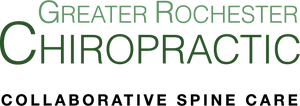Discs can either herniate or degenerate. When a disc herniates, it may bulge out and put pressure on the nerves exiting the spine. Depending on where the herniation is located, this can lead to upper or lower extremity symptoms. When a disc degenerates, it dries out and gets thinner. This results in the vertebra getting closer together and can result in pressure on the nerves exiting the spine. This pressure is due to a reduction in the opening for the nerves to exit.
Both types of disc conditions can be treated effectively with chiropractic care.
LUMBAR DISC HERNIATION – This condition is characterized by lower back pain, and leg pain or numbness, tingling and weakness in just one leg. The symptoms are caused when the disc bulges out putting pressure on the nerves exiting the spine. The leg pain can go below your knee and is usually more severe than the lower back pain. This condition can be very debilitating. Thankfully, 85% of herniated disc conditions will heal with conservative care. Surgery is considered only when there is significant weakness in a lower extremity or the pain is unrelenting and uncontrollable. Ice, spinal manipulation and prescription medication are the first sources of treatment. This condition may take months to fully resolve because of the severity and nerve involvement.
LUMBAR DISC DEGENERATION - This is a chronic condition that takes years to develop. When the discs of the spine start to degenerate, they dry out and become
thinner. The result is that the vertebra get closer together. As the vertebra get closer together, the opening for the nerves to exit the spine become reduced. This condition is
characterized by medium to low grade pain that is usually dull and achy. Ranges of motion are reduced. If the discs become severely degenerative, the nerves may get impinged and
result in pain that radiates down one or both lower extremities. Initial treatment is heat, spinal manipulation and exercise. Since this is a chronic condition, it may take a few months for
this to fully stabilize.o develop. When the discs of the spine start to degenerate, they dry out and become thinner. The result is that the vertebra get closer together. As the
vertebra get closer together, the opening for the nerves to exit the spine become reduced. This condition is characterized by medium to low grade pain that is usually dull and achy.
Ranges of motion are reduced. If the discs become severely degenerative, the nerves may get impinged and result in pain that radiates down one or both lower extremities. Initial
treatment is heat, spinal manipulation and exercise. Since this is a chronic condition, it may take a few months for this to fully stabilize.
CERVICAL DISC HERNIATION – This condition is characterized by neck pain with pain, numbness, tingling and/or weakness in one arm. It is caused by a disc that bulges out putting pressure on the nerves exiting the spine. The arm pain can go into your hands and is usually more severe than the neck pain. This condition can be very debilitating. Thankfully, 85% of herniated disc conditions will heal with conservative care. Surgery is considered only when there is significant weakness in an upper extremity or the pain is unrelenting and uncontrollable. Ice, spinal manipulation, traction and prescription medication are the first sources of treatment. This condition may take months to fully resolve because of the nerve involvement.
CERVICAL DISC DEGENERATION - This is a chronic condition that takes years to develop. When the discs of the spine start to degenerate, they dry out and become thinner. The result is that the vertebrae get closer together. As the vertebrae get closer together, the openings for the nerves to exit the spine become reduced. This condition is characterized by medium to low grade pain that is usually dull and achy. Ranges of motion are reduced. If the discs become severely degenerated, the nerves may get impinged and result in pain that radiates down the upper extremity. Initial treatment is heat, spinal manipulation and sometimes a home traction unit is recommended. Since this is a chronic condition, it may take a few months for this to fully stabilize.
